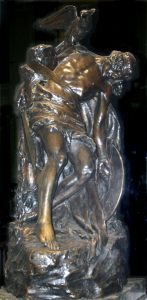M is for Morrigan – Mythic Mondays

Morrigan alights upon the dying Cuchulain
Photo by Kman999 – Kman999 on Flickr, CC BY 3.0
We’re back with the Celts, who love their goddesses in threes. There are three goddesses of Ireland – Eriu, Banba and Fotla. Three goddesses of fertility – Brigid, Boann, and Etain. And three battle goddesses. Morrigan is sometimes one of these, and sometimes the sum of all three. Her sisters are Badb and Macha.
Modern witches tend to clump all these goddesses into a single triumvirate – the Maiden, the Mother, and the Crone. Not all sets of three neatly fit, but there are enough similarities for wiccans to represent the primal forces in this simpler fashion. In this way, they seek to conflate goddess-aspects from many pantheons, to better understand them.
Morrigan is the Crone aspect, signifying mortality and Fate. She is also, in her favorite form of the raven, the chooser of the slain of the Celtic battlefield, combining the roles of both the Norns and Valkyries
Most of the Celtic priesthood – the dru-vids, the Oaken-wise – would worship whichever deity suited their needs, or the needs of their king-host. Dedicated priests were rare, and the Celts saw their gods as merely a more advanced race than humans. Druids were responsible for communicating with the people of Annwn, the Celtic Underworld and Fairyland – not only gods, but any soul which had passed on, and not returned to a new life. Morrigan was appealed to for luck in battle, and in her role as psychopomp, to appeal to souls resident in Annwn
Story of the God
When Maeve stole the cattle of Ulster, all the men but Cuchullin were struck by a weakness. Cuchullin was only immune because he was only half a son of Ulster – half of his heritage was divine, being a son of Lugh.
So Cuchullin stood at the ford where the great river runs which borders Ulster, to fight against the champions of Maeve in single combat.
The Morrigan in the guise of a beautiful blond girl, came to offer him her love, and her aid in the battle. But Cuchullin rejected her.
So she went away and changed into the form of an eel. At the height of the fight. she tripped him, and he wounded her, but he won despite that.
So, Morrigan came again in her guise as a wily red headed girl and offered him magical aid in the battle, and her loving embrace. But Cuchullin rejected her.
So she went away and came back in the form of a wolf. At the height of the fight. she scared cattle over him, and he wounded her, but he won despite that.
For the third night, Morrigan came in the guise of a dark haired beauty, offering strength for the coming battle, and loving rest in her arms. And again Cuchullin rejected her.
So she went away and came back in the form of a red heifer. At the height of the fight. she led a stampede of cattle over him, and he wounded her, but he won despite that.
So, after the battle Morrigan appeared in the form of an old woman bearing the three wounds he had given her, and leading a cow. So Cuchullin knew that what faced him was one of the Tuatha de Danann. She offered Cuchullin a draught of milk, and he blessed her for it. His blessing healed her wounds, and in return she had nothing but the prophecy of his death.
“Had I known you, I might not have rejected you”
“You would have, for it is in your nature to be stubborn. And it is in this that your death lies, for in rejecting help, you rejected that which might have saved your life”
And so it came that a mighty army came, and one man could not stand against it. Whilst the Ulstermen recovered in time to save their country, it was not soon enough to save Cuchullin
In Your Games and Stories
As the weaver of Fate, Morrigan might give clerical spells of divination, and inspire works of craft – great swords, mighty shields, or tools to aid in foretelling the future. All the Celtic deities have a connection with song, so her followers would number bards as well as druids and clerics. Whilst her battle-aspect would imply her to be a favorite of fighters, few wished to incur her notice, preferring Ogma, Lugh or even Brigid
Castles belonging to followers of Morrigan would tend to be defended by puzzles and traps rather than monsters – unless you count hordes of fey warriors. Seek her in hollow hills and remote crags – or in Annwn, the Celtic Fairyland.
Morrigan could also appear in a political tale, in her role as outsider and observer. She might well know secrets unavailable elsewhere. But what price will the Lady of Fate require for her aid? Perhaps, like the blood-price for the Sons of Tuirenn, it will sound innocuous and be the source of a whole adventure to find.
If you’re looking for more Fae Fantasy, join Artemis Games Jigsaw Fantasy Patreon and put in your vote.

Pingback: Alphabetically Binge Collected Deities - Easily